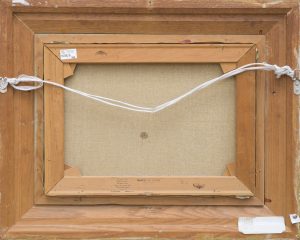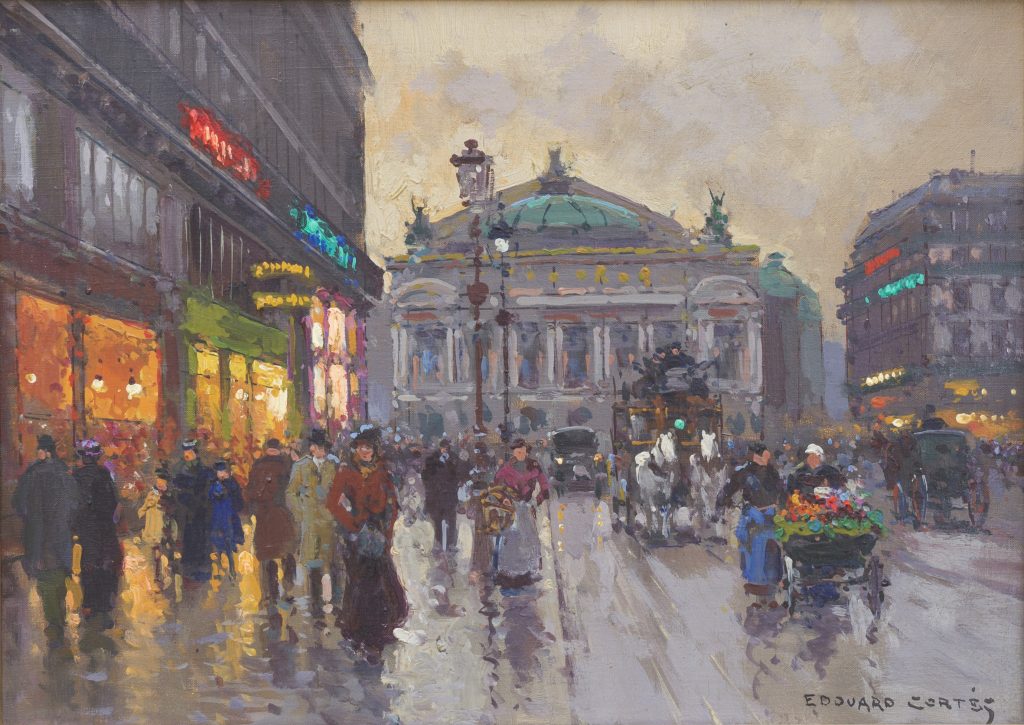Edouard Léon CORTÉS
Paris, France
Marchande de fleurs, Avenue de l'Opera
33x46cm
Signed Edouard Cortès (lower right)
“I do nothing but paint. I stand in front of my easel at around eight in the morning; from twelve to two I eat lunch and rest, and I paint in the afternoon till dusk, because I don’t like artificial light. That gives me eight to ten hours a day to paint”.
Èdouard Leon Cortès, the son of a court painter Antonio Cortès was born in Lagny, close to Paris at the end of the XIX century, when The City of Lights was the artistic capital of the world and when the new art, symbolised by the Impressionism had already been spread. Cortès was primarily trained by his father, an adherent of a Barbizon school, whose painters took their inspiration in nature itself, enjoying the freedom of observation rather than following the Academic rules of the time. Participant of many of Paris artistic Salons, Cortès had been also awarded a prestigious Prix Antoine-Quinson.
Looking at Cortes’s oeuvre, one may immediately grasp his awareness and adherence of the Barbizons. Although set in urban landscapes, his paintings convey the same fine sensuality in the tratment of details such as the colour of the sky and leaves, shapes of trees, reflections on the ground and inviting electric lights.
In his iconic views of Paris of the beginning of the XX century, Èdouard Cortès carries over the wistful, sensitive and observative manner of Barbizons, combining it with a soft touch of Impressionism to create a Romantic vision, a souvenir from that time, an image of the city that has been rapidly changing and growing.
However, his views of Paris of the first quarter of the century bear as well a sentimental meaning, as the artist had admitted he had wished to stop history before the Second World War. It is a part of a famous European nostalgia for prosperity and peace of La Belle Époque, and Cortes prolongs this period up to the end of 1930s, a sort of a lost paradise. His idealisation of the period, on the other hand, does not bear a character of aristocratic splendour and prosperuity, Cortes is rather keen in depicting ordinary everyday life of the city and its crowd.
“Avenue de l’Opera”
As post-war agony loomed over the early 20th-century socio-political terrain, the conventional impressionistic approach to landscape adopted by Cortés at the rise of his career developed a new, sentimental dimension. Here, the once idyllic visions of the Parisian metropolis constitute a newer, muted urban image. However melancholic, his composition is swarming with an eclectic selection of figures, conveying Cortés’s bewitchment by depicting the organic life before his eyes. Communicating the transience so unremitting to urban life, the artist uses his masterly skill in a loosely applied, yet meticulous brushwork to construct an image of constant movement that characterises the fleeting visions of the metropolis landscape. The artist navigates the earthy tones of the canvas by dispersing vibrant accents of colour, allowing reds, blues, and yellows to capture the bustling, atmospheric quality of the city amongst the backdrop of deeper colour. While Cortés’s wartime experience undoubtedly tainted his perception of life surrounding him, it also amplified his zealous appreciation of the romantic, so commonly hidden within everyday scenes; he is compelled to perceive the seemingly ordinary metropolis experience through the prism of a nuanced approach. The image presents a distillation of lengthy outdoor observation and sentimental memory, granting its viewer a glimpse of inter-war modernity and drastic societal reformation.


Provenance:
Private collection, New York
Private collection, Zürich


